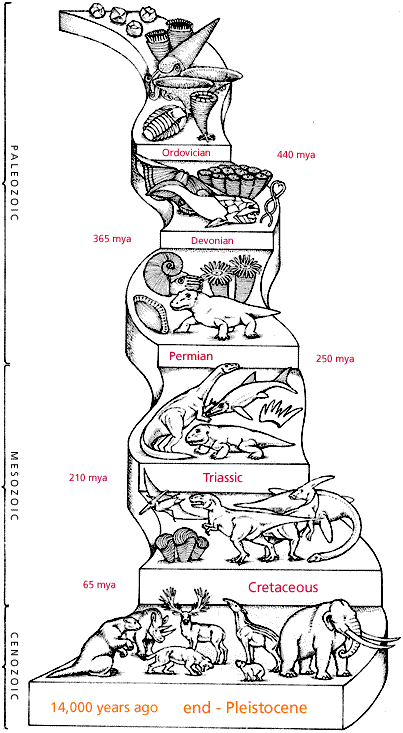
|
||||||||||||
|
|
|
Mass Extinctions
More than 90 percent of all organisms that have ever lived on Earth are extinct. As new species evolve to fit ever changing ecological niches, older species fade away. But the rate of extinction is far from constant. At least a handful of times in the last 500 million years, 50 to more than 90 percent of all species on Earth have disappeared in a geological blink of the eye. A mass extinction or extinction event is the phenomenon in which a large number of species of life on Earth become extinct in a relatively short period of time. In general usage by scientists, "mass extinction" refers to an extinction affecting a great many different groups of organisms occupying diverse and wide-spread environments. Extinction of species, genera, families, and even orders of organisms has occurred throughout the history of life on Earth, but mass extinctions are those events that greatly exceed the normal or background extinction rate.
Top 5 Extinctions Cretaceous-Tertiary extinction, about 65 million years ago, probably caused or aggravated by impact of several-mile-wide asteroid that created the Chicxulub crater now hidden on the Yucatan Peninsula and beneath the Gulf of Mexico. Some argue for other causes, including gradual climate change or flood-like volcanic eruptions of basalt lava from Indias Deccan Traps. The extinction killed 16 percent of marine families, 47 percent of marine genera (the classification above species) and 18 percent of land vertebrate families, including the dinosaurs. End Triassic extinction, roughly 199 million to 214 million years ago, most likely caused by massive floods of lava erupting from the central Atlantic magmatic province -- an event that triggered the opening of the Atlantic Ocean. The volcanism may have led to deadly global warming. Rocks from the eruptions now are found in the eastern United States, eastern Brazil, North Africa and Spain. The death toll: 22 percent of marine families, 52 percent of marine genera. Vertebrate deaths are unclear. Permian-Triassic extinction, about 251 million years ago. Many scientists suspect a comet or asteroid impact, although direct evidence has not been found. Others believe the cause was flood volcanism from the Siberian Traps and related loss of oxygen in the seas. Still others believe the impact triggered the volcanism and also may have done so during the Cretaceous-Tertiary extinction. The Permian-Triassic catastrophe was Earths worst mass extinction, killing 95 percent of all species, 53 percent of marine families, 84 percent of marine genera and an estimated 70 percent of land species such as plants, insects and vertebrate animals. Late Devonian extinction, about 364 million years ago, cause unknown. It killed 22 percent of marine families and 57 percent of marine genera. Erwin said little is known about land organisms at the time. Ordovician-Silurian extinction, about 439 million years ago, caused by a drop in sea levels as glaciers formed, then by rising sea levels as glaciers melted. The toll: 25 percent of marine families and 60 percent of marine genera. The IUCN Red List of Threatened Species (version 2010.4) contains 55,926 species and 33% of these (18,351 species) are known to be threatened. This is a minimum estimate; at least some of the 8,358 Data Deficient species will be threatened (many will be rare or restricted range species). Estimates of global species diversity have varied from 2 million to 100 million species, with a best estimate of somewhere near 10 million, and only 1.75 million known species of living organisms on earth have been identified.
The biological impoverishment of the Earth is accelerating as human population grows. The share of bird, mammal, and fish species that are now in danger of extinction is in double digits—11 percent of all bird species, 25 percent of mammals, and 34 percent of fish. Over 19,000 plant species and 5000 animal species are classified as endangered. 99% of threatened species are at risk from human activities. Rainforests are home to 50 to 70% of all life forms on Earth. Coral Reefs and the Oceans are home to 25% to 30% of all life forms. At the current rate of destruction how long will it be before human beings become endangered? Scientists estimate an average of 137 species of life forms are driven into extinction every day for a total of 50,000 each year. The greatest mass extinction of species since the extinction of the dinosaurs 65 million years ago is now occurring. If present trends continue one half of all species of life on earth will be extinct in less than 100 years, as a result of habitat destruction, pollution, invasive species, and climate change.
|



